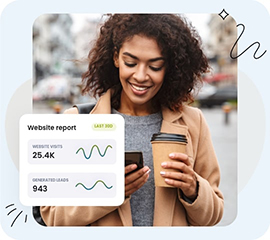Website design needn’t be complicated with HostPapa’s Website Builder. In this article, we show you how Website Builder makes website design changes simple.
To learn how to access your Website Builder to get started, please visit this article.
Please don’t forget to read to the end of this article, where we share nine tips for website design victory!
Website design: What is it?
Website design is the process of planning, conceptualizing, and arranging content for websites. The idea is to create visually appealing, functional, and user-friendly online experiences.
Website design also involves combining aesthetics and usability to create websites that are both visually appealing and easy to use. Elements of website design include:
- Arranging content and visuals for a clear online presentation.
- Balancing appearance with user experience and functionality.
- Adding practical layouts, colors, typography, images, and interactive elements.
- Considering navigation, accessibility, and mobile responsiveness.
- Communicating clearly and using brand expression.
Changing your website’s design
Website design in Website Builder can be changed at any time. All of your existing website content will be preserved and intact whenever you change the design of your website.
To apply a new design to your website, please:
- Select Design from your Left Menu.
- Go to the Business vertical drop-down menu.
- Browse the preset images.
- Choose a design for your website.
If you would like to see a larger design preview during the above process, please:
- Click Live Preview.
Website Design: 9 Tips for website design success
Creating a successful website goes far beyond making something that looks attractive. The best websites are built on strong fundamentals: clarity, ease of use, responsiveness, and a deep understanding of your audience.
Below are nine expert-backed tips, each accompanied by practical bullet or numbered lists to help you nail your next web design project.
1. Prioritize user-centric design
Your audience must always come first. Web design must revolve around users’ needs—helping them navigate and understand your website with ease.
- Identify your target users and create detailed personas.
- Map out what users want to accomplish on your site.
- Test layouts with real users and gather continual feedback.
2. Keep the design simple and streamlined
Simplicity augments usability and helps users focus on what matters. Overly busy designs can overwhelm and distract.
- Limit the number of fonts and colors.
- Use short paragraphs and bullet points for clear information.
- Remove unnecessary elements that don’t serve a direct purpose.
3. Embrace mobile-first and responsive design
With a majority of users browsing on mobile, your website can look and function flawlessly on all screens.
- Use fluid grids and flexible images.
- Test on multiple devices and browsers.
- Streamline for fast loading times on mobile networks.
4. Guarantee fast load times
A slow website frustrates users and leads to higher bounce rates.
Ways to upgrade speed:
- Compress images without losing quality.
- Minimize the use of heavy animations and scripts.
- Use modern, structured coding practices.
5. Make navigation intuitive
Good navigation makes sure visitors find what they need quickly and easily.
- Use clear, hierarchical menus.
- Make sure all navigation elements are easily accessible, particularly on mobile.
- Include a search feature for larger sites.
6. Use visual hierarchy and whitespace
Guide the user’s attention to the most important content first.
- Make headings larger and bolder than regular text.
- Use color contrast to highlight CTAs.
- Apply whitespace to separate different sections and prevent clutter.
7. Stick to consistent branding
Consistency in branding builds recognition and trust.
Elements to standardize:
- Color palette (choose 3—5 colors).
- Fonts (1—2 max, always legible).
- Logo placement (typically top left).
- Image and illustration style.
8. Craft clear calls-to-action (CTAs)
Every page must direct users toward the next step—make your CTAs prominent and persuasive.
- Use action-oriented language (Sign Up, Get Started).
- Make buttons stand out with color.
- Position CTAs strategically above the fold and at logical stopping points.
9. Design for accessibility and inclusivity
A good website aims to serve all visitors, including those with disabilities. Consider accessibility and also:
- Use proper contrast ratios between text and backgrounds.
- Add alternative (alt) text to all images.
- Make sure navigation and interactive elements are keyboard-accessible.
- Test with screen readers and accessibility tools.
Quick reference: future success
Tips for ongoing development
- Continually collect feedback from visitors.
- Monitor analytics and tweak based on user behavior.
- Keep updated on design trends but never sacrifice usability.
Common usability issues to avoid
- Tiny or unreadable fonts.
- Overlapping elements on mobile.
- Confusing menu structures.
- Overuse of popups.
Launch checklist
- Review all content for accuracy and clarity.
- Test site speed on both desktop and mobile devices.
- Perform accessibility audits.
- Double-check links, forms, and interactive features.
A great website isn’t just a result of clever visuals or technological wizardry—it’s a human-first product.
By focusing on user needs, clarity, and accessibility, you’ll create a website that’s not just beautiful but helpful in meeting your business goals.
If you need help with your HostPapa account, please open a support ticket from your dashboard.




